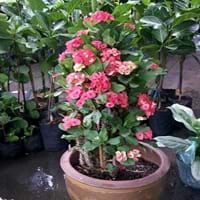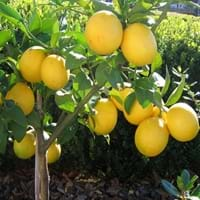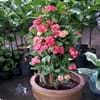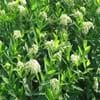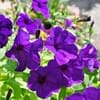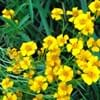Life Span
Perennial
Perennial
Origin
Madagascar
Hybrid origin
Types
Not Available
Not Available
Habitat
Forests, Rocky areas
Warmer regions
USDA Hardiness Zone
10-15
9-11
Sunset Zone
H1, H2, 13, 21, 22, 23, 24
H1, H2, 8, 9, 12, 13, 14, 15, 16, 17, 18, 19, 20, 21, 22, 23, 24
Habit
Oval or Rounded
Oval or Rounded
Flower Color Modifier
Not Available
Bicolor
Fruit Color
Non Fruiting Plant
Orange, Lemon yellow
Leaf Color in Spring
Green
Dark Green
Leaf Color in Summer
Green
Dark Green
Leaf Color in Fall
Green
Dark Green
Leaf Color in Winter
Green
Light Green
Leaf Shape
Obovate
Elliptic
Plant Season
Spring, Summer, Fall, Winter
Spring, Summer, Fall, Winter
Sunlight
Full Sun
Full Sun
Type of Soil
Loam, Sand
Loam, Sand
The pH of Soil
Acidic, Neutral
Acidic, Neutral, Alkaline
Soil Drainage
Well drained
Well drained
Bloom Time
Spring, Late Spring, Early Summer, Summer, Late Summer
Indeterminate
Tolerances
Not Available
Drought
Where to Plant?
Ground, Pot
Container, Ground, Pot
How to Plant?
stem tip cuttings
Cuttings
Plant Maintenance
Medium
Medium
Watering Requirements
Average Water Needs
Average Water Needs
In Summer
Lots of watering
Lots of watering
In Spring
Moderate
Moderate
In Winter
Average Water
Average Water
Soil pH
Acidic, Neutral
Acidic, Neutral, Alkaline
Soil Type
Loam, Sand
Loam, Sand
Soil Drainage Capacity
Well drained
Well drained
Sun Exposure
Full Sun
Full Sun
Pruning
Remove damaged leaves, Remove dead branches, Remove dead leaves
Remove damaged leaves, Remove dead branches, Remove dead leaves
Fertilizers
Full-strength liquid fertilizer
All-Purpose Liquid Fertilizer
Pests and Diseases
Red blotch
Aphids, Psyllids, Scale insects, Whiteflies
Plant Tolerance
Drought
Drought
Flower Petal Number
Single
Single
Fragrant Bark/Stem
No
Yes
Foliage Texture
Medium
Medium
Foliage Sheen
Matte
Glossy
Attracts
Ants, Bees, Not Available
Birds, Butterflies
Allergy
Eye irritation, Skin irritation, Vomiting
Acidic, Nausea
Aesthetic Uses
Borders
Showy Purposes
Beauty Benefits
Not Available
Not Available
Environmental Uses
Air purification
Air purification
Medicinal Uses
Antibacterial, Cancer, Schistosomiasis, Sedative
Nutrients
Part of Plant Used
Flowers, Latex
Fruits, Leaves
Other Uses
Used as Ornamental plant
Used As Food, Used to make juice
Used As Indoor Plant
Yes
Yes
Used As Outdoor Plant
Yes
Yes
Garden Design
Bedding Plant, Container, Edging, Foundation, Houseplant, Mixed Border, Tropical
Container, Edible, Feature Plant, Fruit / Fruit Tree, Houseplant, Topiary / Bonsai / Espalier, Tropical
Botanical Name
EUPHORBIA milii
Citrus Meyeri
Common Name
Crown of thorns, Christ plant, Christ thorn
Meyer Lemon
In Hindi
Crown-of-Thorns
Meyer Lemon
In German
Dornenkrone
Meyer Lemon
In French
Couronne d'épines
Meyer Lemon
In Spanish
Corona de espinas
Meyer Lemon
In Greek
Crown - of- Αγκάθια
Meyer Lemon
In Portuguese
Crown -de- espinhos
Meyer Lemon
In Polish
Korona cierniowa
Meyer Lemon
In Latin
Coronam de spinis
Meyer Lemon
Phylum
Magnoliophyta
Magnoliophyta
Class
Magnoliopsida
Magnoliopsida
Order
Euphorbiales
Sapindales
Family
Euphorbiaceae
Rutaceae
Clade
Angiosperms, Eudicots, Rosids
Angiosperms, Eudicots, Rosids
Tribe
Euphorbieae
Citreae
Subfamily
Euphorbioideae
Aurantioideae
Number of Species
Not Available
Properties of Crown-of-Thorns and Meyer Lemon
Wondering what are the properties of Crown-of-Thorns and Meyer Lemon? We provide you with everything About Crown-of-Thorns and Meyer Lemon. Crown-of-Thorns has thorns and Meyer Lemon doesn't have thorns. Also Crown-of-Thorns does not have fragrant flowers. Crown-of-Thorns has allergic reactions like Eye irritation, Skin irritation and Vomiting and Meyer Lemon has allergic reactions like Eye irritation, Skin irritation and Vomiting. Compare all the properties and characteristics of these two plants. Find out which of these plant can be used as indoor plant. If you are interested to decorate your house and garden, find out aesthetic uses, compare them and select the plant which will beautify your surrounding. Along with beautification, try comparing medicinal and edible uses of Crown-of-Thorns and Meyer Lemon and you can choose the plant having best and most benefits.
Season and Care of Crown-of-Thorns and Meyer Lemon
Season and care of Crown-of-Thorns and Meyer Lemon is important to know. While considering everything about Crown-of-Thorns and Meyer Lemon Care, growing season is an essential factor. Crown-of-Thorns season is Spring, Summer, Fall and Winter and Meyer Lemon season is Spring, Summer, Fall and Winter. The type of soil for Crown-of-Thorns is Loam, Sand and for Meyer Lemon is Loam, Sand while the PH of soil for Crown-of-Thorns is Acidic, Neutral and for Meyer Lemon is Acidic, Neutral, Alkaline.
Crown-of-Thorns and Meyer Lemon Physical Information
Crown-of-Thorns and Meyer Lemon physical information is very important for comparison. Crown-of-Thorns height is 300.00 cm and width 45.70 cm whereas Meyer Lemon height is 180.00 cm and width 240.00 cm. The color specification of Crown-of-Thorns and Meyer Lemon are as follows:
Crown-of-Thorns flower color: Red
Crown-of-Thorns leaf color: Green
Meyer Lemon flower color: White
- Meyer Lemon leaf color: Dark Green
Care of Crown-of-Thorns and Meyer Lemon
Care of Crown-of-Thorns and Meyer Lemon include pruning, fertilizers, watering etc. Crown-of-Thorns pruning is done Remove damaged leaves, Remove dead branches and Remove dead leaves and Meyer Lemon pruning is done Remove damaged leaves, Remove dead branches and Remove dead leaves. In summer Crown-of-Thorns needs Lots of watering and in winter, it needs Average Water. Whereas, in summer Meyer Lemon needs Lots of watering and in winter, it needs Average Water.
